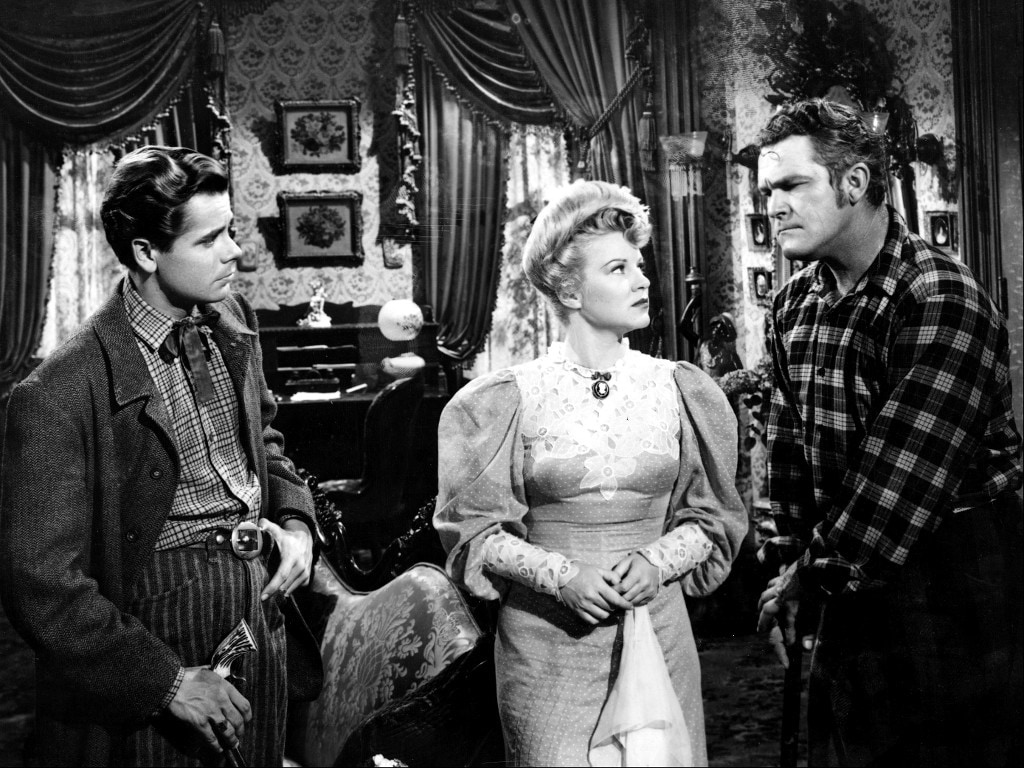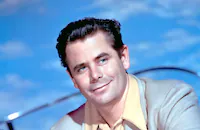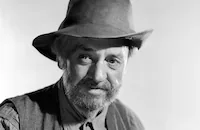The Desperadoes

Brief Synopsis
Cast & Crew
Charles Vidor
Randolph Scott
Claire Trevor
Glenn Ford
Evelyn Keyes
Edgar Buchanan
Film Details
Technical Specs

Synopsis
When the bank is robbed in the town of Red Valley, Utah, banker Stanley Clanton magnanimously offers to repay personally fifty percent of his depositors' losses. Unknown to the grateful depositors, Clanton has masterminded the bank robbery with Uncle Willie McLeod, the town postmaster and stable owner. Uncle Willie is furious with Clanton for refusing to wait for the gunslinger he hired to rob the bank and instead hiring the vicious Jack Lester, who killed three men during the robbery. While searching for clues to the robbers' identity, town sheriff Steve Upton stops to water his horse. As he dismounts, a man approaches from his rear and demands the horse at gunpoint. The man is Cheyenne Rogers, the gunslinger hired by Uncle Willie to rob the bank. Cheyenne rides into town and at the stable meets Uncle Willie's daughter, Allison McLeod. Although she recognizes the horse as belonging to Steve, Allison is charmed by the handsome cowboy, who introduces himself as Bill Smith. From the stables, Cheyenne proceeds to the casino and hotel, where he meets "The Countess," the proprietor and his childhood friend. The Countess is sympathetic when Cheyenne despairs of ever being able to "go straight" because of the $10,000 reward offered for his capture. Their discussion is interrupted by an explosion, followed by the entrance of Nitro Rankin, Cheyenne's partner. Nitro has injured his leg in the blast, and Cheyenne refuses to leave town until his partner is well enough to ride. Meanwhile, Allison rides out to find Steve and tells him about the stranger. That night, when Cheyenne returns to the stables to see Allison, Steve is waiting to arrest him. When Steve recognizes the horse thief as his old friend Cheyenne, he invites him for a drink. As they walk toward the saloon, Uncle Willie recognizes Cheyenne as the man he hired to rob the bank and anxiously advises him to leave town. Later, when the townsfolk become impatient and demand the arrest of the bank robbers, Steve confides to Uncle Willie that he thinks that rancher Jack Lester was responsible for the theft, and Willie passes the information along to Clanton. Deciding to go straight for Allison's sake, Cheyenne puts away his guns and gets a job at a ranch breaking broncos to sell to the army. Concerned about her friend's safety, the Countess begs him to leave town and later confesses to Nitro that she blames herself for Cheyenne's predicament because he originally strapped on his guns to defend her from claim jumpers. Deciding to shield himself from Steve's suspicions by framing Cheyenne for the robbery, Lester publicly accuses him of the crime. Knowing that Lester will eventually challenge Cheyenne to a gunfight, Steve orders his friend to leave town by morning. That morning, just as Cheyenne is about to mount his horse, Nitro gallops up and announces that he has robbed the bank. The two men ride out of town pursued by a posse and are captured in a box canyon. At their trial, Lester testifies that he saw Nitro and Cheyenne kill the men in the first robbery, and although Steve and Uncle Willie come to their defense, Judge Cameron sentences them to hang. Believing in their innocence, Steve allows them to escape and is jailed for his good deed. Later that night, Cheyenne returns to town and forces a confession from Lester. Cheyenne then goes to the stables to see Allison and upon learning that Steve is in jail, instructs Uncle Willie to tell Clanton to release the sheriff or he will return to town with blazing guns. Fearing for Cheyenne's life, Allison visits the Countess to beg her to convince Clanton to release Steve. Uncle Willie watches with a heavy heart as his daughter leaves the casino. Meanwhile, Nitro and Cheyenne watch as the wranglers drive the horses to town to sell to the army. Realizing that Clanton will rob the bank once the horses are sold, Cheyenne decides to join the drive and instructs Nitro to detonate an explosion as the herd nears town. At the sound of the blast, the horses stampede, and Cheyenne rides into town under cover of the stampeding herd. After Cheyenne passes a gun to Steve through the jailhouse window, the sheriff escapes from his cell, and the two friends proceed to the saloon to confront Lester and his men. In the mêlée, Uncle Willie discovers Clanton readying to leave town and shoots him. Joining Cheyenne and Steve in the saloon, Nitro eliminates the outlaws with a well-aimed blast. As Steve steps into the street to calm the crowd, Uncle Willie pulls up in his buckboard and announces that he caught Clanton running out of town with the bank deposits and shot him. Before dying, Uncle Willie claims, the banker confessed that he and Lester stole the money. Later, in the jailhouse, Uncle Willie watches from behind bars as Allison marries Cheyenne.

Director

Charles Vidor
Cast

Randolph Scott

Claire Trevor

Glenn Ford

Evelyn Keyes

Edgar Buchanan

Guinn "big Boy" Williams

Raymond Walburn

Porter Hall

Joan Woodbury
Bernard Nedell

Irving Bacon

Glenn Strange
Ethan Laidlaw

Charles Whitaker
Edward Pawley
Chester Clute
William Gould
Hugh Prosser
Tom Yuen
Lee Moore
Francis Ford
George Sherwood
Reed Howes
Billy Jones
Bill Patton
Edward Peil Sr.
Eugene King
Eddie Laughton
Crew
Lionel Banks
Max Brand
Harry Joe Brown
H. Clay Campbell
Robert Carson
Allen M. Davey
Lambert Day
Gene Havlick
Helen Hunt
Loran Jones
Natalie Kalmus
John Leipold
George Meehan
Morgan Padelford
George Rhein
Perry Smith
M. W. Stoloff
Travilla
Frank [a.] Tuttle

Film Details
Technical Specs

Articles
The Desperadoes
Charles Vidor was the director of The Desperadoes. The Hungarian film helmsman, born Karoly Vidor and no relation to other famous filmmaker King Vidor, is now best known for musicals like Cover Girl (1944) and Love Me or Leave Me (1955) but here he shows a talent for the American Western, creating a lively action-filled spectacle. Meanwhile, Robert Carson's script introduces a complex plot unusual in the genre for its time with morally ambiguous characters - a sheriff with a checkered past, an outlaw who wants to go straight and an upstanding citizen who is actually the mastermind behind a bank robbery.
Another strange touch in the script, different from the norm, is a strong accent on humor in the action scenes. More even than the humorous satire Destry Rides Again (1939), there are a lot of laughs during action scenes, particularly in a barroom brawl while a table of gamblers in the middle of it all try to keep playing even as they lose members to flying bottles.
The actors are game as well. Randolph Scott is the nominal hero but, even as sheriff, he seems ineffectual next to second-billed youngster Glenn Ford playing the outlaw-turned-good-guy Cheyenne. Ford was then an up-and-coming contract player at Columbia and he dominates this movie. Director Vidor must have been impressed as three years later he gave Ford the male lead in the star-making Gilda (1946). Evelyn Keyes is the love interest although Claire Trevor makes much more of an impression as "The Countess." Dressed in Technicolor finery, she underlines all the dropped hints about her character (a prostitute and Cheyenne's former lover) that Hollywood's Breen Office was trying to keep from the public.
Another actor obviously enjoying a larger part than usual is character actor Edgar Buchanan playing Keyes' father and secretly in league with the robbery scheme. Now better known for playing Uncle Joe ("movin' kinda slow") in the 60's TV series Petticoat Junction, Buchanan is wonderful here playing a doting father trying to protect his virginal daughter while hiding his own crimes. It's a fascinating portrayal that tempers his character's villainy with sympathy and pity.
The Desperadoes is full of great moments and lively performances, far more than a movie that could have just been the announcement that Columbia now had color, too. The studio took the trouble to deliver an "A" picture despite its "B" classification and its stature deserves to be elevated to that of the other great westerns of the forties.
Director: Charles Vidor
Screenplay: Robert Carson, based on the story by Max Brand
Producer: Harry Joe Brown
Cinematographers: George Meehan, Allen M. Davey
Music: John Leipold
Editor: Gene Havlick
Cast: Randolph Scott (Steve Upton), Claire Trevor (Countess), Glenn Ford (Cheyenne), Evelyn Keyes (Allison McLeod), Edgar Buchanan (Uncle Willie McLeod), Guinn 'Big Boy' Williams (Nitro).
C-87 min.
by Brian Cady

The Desperadoes
Quotes
Trivia
The first Technicolor feature film for Columbia Pictures.
Notes
The working title of this film was The Pioneers. Although this was Columbia's first Technicolor production, the viewed print was in black and white and the Technicolor credits were blacked out. The film's opening credits are presented in the form of a book titled The Desperadoes. Each page of the book features the picture and name of an actor in the film, similiar to a style popular in the early 1930's. The opening also contains the following prologue: "1863-the newest frontier was Utah. Utah's gold was its wild horses, which the Union Army was seeking to buy. Men rushed to the new frontier-some to break these horses, others to break the law."
According to a news item in New York Times and an unidentified contemporary source in the AMPAS Library Production Files, the film introduced several technological innovations. To circumvent the government prohibition on outdoor night filming, photographer George Meehan experimented with new filters, special makeup and lighting backgrounds to simulate night scenes. The picture's tracking shots were filmed by a vehicle that carried six cameras and eighteen men and could attain speeds of eighty miles an hour. A Hollywood Reporter news item adds that scenes were shot in Kanab, Utah. Claire Trevor and Glenn Ford had previously starred together in the 1941 Columbia western Texas (see below).

Miscellaneous Notes
Released in United States 1943
Released in United States on Video July 9, 1996
Released in United States 1943
Released in United States on Video July 9, 1996













